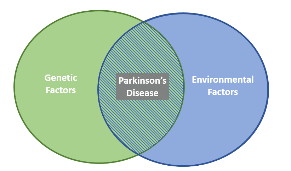Parkinson’s disease is the second most common movement disorder, occurring in 1-3% of the population. The age of onset is typically around age 60, though the disease can occur earlier or later. In Parkinson’s disease, there is malfunction and loss of cells in the brain that produce dopamine as well as changes in other brain regions.
It is important to remember that symptoms, age of onset, and rate of progression can vary greatly from person to person. A diagnosis of Parkinson’s disease is made based on the presence of clinical features, such as tremors, bradykinesia (slowness), and rigidity (stiff movements). People with Parkinson’s disease can also experience non-motor symptoms such as sleep disorders, mood problems, and cognitive changes. Although there is not yet a cure or way to slow the progression of Parkinson’s disease, there are medications and surgical options that can improve the symptoms. Lifestyle behaviors such as engaging in exercise may help delay onset and progression.
What Causes Parkinson's Disease?
We have learned so much about Parkinson's disease in the last few decades, including what causes it. Previously, it was thought that genetics had little or no contribution. We now know that for most cases it is a combination of environment, age, genetics, and lifestyle.

Our group is especially interested in the genetics of Parkinson’s disease. For more information about the causes of Parkinson’s disease, including environmental factors, you can visit this National Institute of Health (NIH) page".

Parkinson’s disease is a complex disorder, thought to be multifactorial in most families. It is likely caused by an interplay of both genetic and environmental factors.
Some people may be the first to be diagnosed with Parkinson’s disease in their family, others may have many family members with the disease. A number of genes have been identified as risk factors for Parkinson’s disease, with many others likely unknown.
